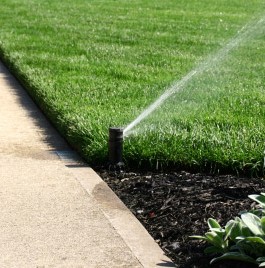Water conservation tips for both in- and outside of the home
Using water conservation activities can help improve the environment, ensure water resources for the community and save homeowners money on utility bills.
 There are as many ways to conserve water as
there are to use water. Knowing how you use it can help you determine the ways in
which you can save the most. Identifying where the most use of water in and
outside the home will help you find the best ways to save water and money! The
following ideas are a start.
There are as many ways to conserve water as
there are to use water. Knowing how you use it can help you determine the ways in
which you can save the most. Identifying where the most use of water in and
outside the home will help you find the best ways to save water and money! The
following ideas are a start.
Bathroom
- This is the biggest area of water use with the toilet being the number one user of water in the home.
- If the toilet was installed prior to 1992, it is not a 1.6 gallon per flush model. If it doesn’t need replacing, install a tank bank or plastic jug filled with water in the tank to reduce the water usage from 4 or more gallons to 3 gallons per flush. Keep in mind that at least 3 gallons is needed to ensure proper flushing.
- Check the toilet for leaks. Place a few drops of food coloring into the tank. Within 30 minutes, if the food coloring appears in the bowl without flushing, there is a leak that needs repair.
- Install low–flow faucet aerators and showerheads. Using these low-flow devices is the best water conservation action to take and usually the cheapest.
- Take showers instead of baths. Filling the tub uses more water than a shower. Take shorter showers. Every minute, 5-10 gallons of hot water is running down the drain.
Kitchen
- Only run the dishwasher when there’s a full load.
- Check dishwasher detergent directions. Most do not recommend pre-rinsing dishes before putting in the dishwasher.
- When hand washing dishes, use one bowl to wash and fill the other bowl with rinse water. For a single bowl, wash and stack dishes in a drainer, then rinse with a sprayer.
- Use the garbage disposal sparingly. Disposers require a lot of water to run properly.
- Use a bowl or pan filled with water to wash and rinse fruits and vegetables.
- Keep a pitcher or beverage dispenser of water in the refrigerator. This will eliminate running the faucet to get a cold glass of water.
Laundry
- Washing clothes is the second largest use of water in the home.
- Wash only full loads of clothes or adjust the water level to the amount of clothes.
- Use the correct amount of detergent to eliminate second rinses.
Yard
- Use a bucket with soapy water to wash the car. Then rinse using a spray nozzle on the hose for the most efficient use of water.
- Water the lawn early in the day. This reduces evaporation loss and helps prevent the growth of fungus on the lawn.
- Add mulch or other organic matter around trees and shrubs. This material holds moisture and reduces the need for frequent watering.
- Make sure the sprinkler is set correctly to water the lawn. Overspray just runs down the walk or driveway and into the storm sewer.
- Use a timer when watering the lawn to remember to move the sprinkler to a new area or turn it off.
- Install a cover on your pool. This will reduce evaporation and the need to keep refilling the pool. If you use a solar cover, it will also reduce energy use by not running the pool heater as much.
- Use a broom to clean off sidewalks and driveways. Using a hose to clean these areas can use 80 gallons each time.
Basement
- Insulate water pipes and the hot water heater. Insulating these keeps hot water hotter in the tank and in the pipes so it reduces the amount of time the faucet will run to get the desired water temperature.
For more information and water saving ideas, see Michigan State University Extension’s Home*A*Syst bulletin (WQ 51) available through your local Extension office or the MSU Bookstore.



 Print
Print Email
Email


